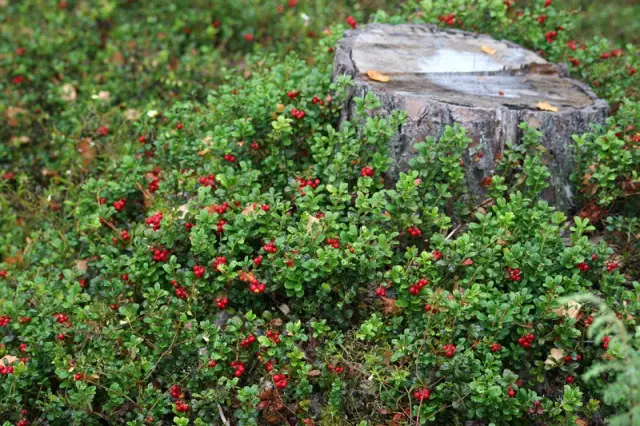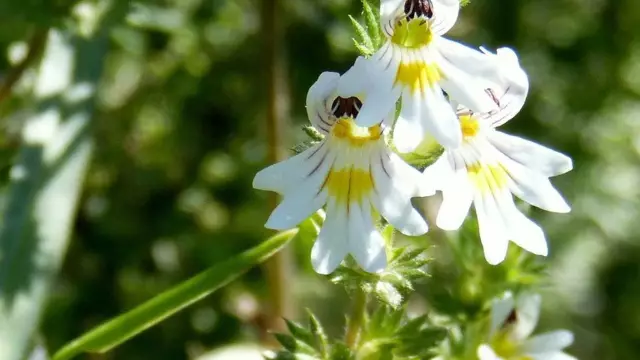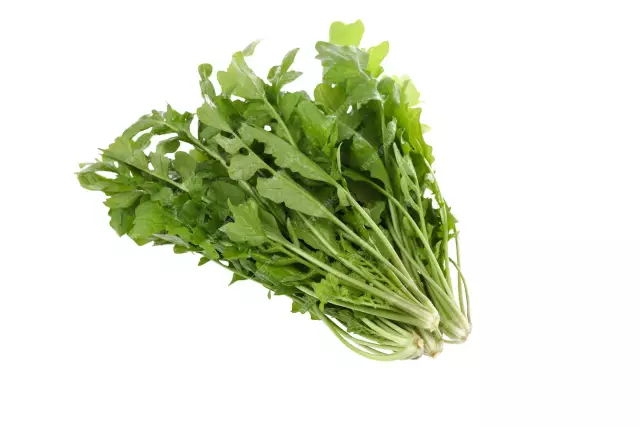- Author Rachel Wainwright [email protected].
- Public 2023-12-15 07:39.
- Last modified 2025-11-02 20:14.
Honeysuckle
Honeysuckle is a plant from the genus of perennial shrubs. The common name for honeysuckle in the wild is the expression "wolfberry". It can grow as a creeping, climbing or erect shrub with large fragrant flowers of light color (white, light blue, light pink or light yellow). The height of the honeysuckle bush can reach 2 meters or more.
The ratio of BJU in the product

Source: depositphotos.com How to burn 43 kcal?
| Walking | 11 minutes |
| Jogging | 5 minutes. |
| Swimming | 4 minutes |
| A bike | 6 minutes |
| Aerobics | 9 minutes |
| Household chores | 14 minutes |
The fruits or berries of honeysuckle are blue or dark blue in color, with a characteristic waxy bloom; they can be round or elongated in shape. Honeysuckle berries are always arranged in pairs, even sometimes growing together. To the taste, honeysuckle berries are somewhat reminiscent of blueberries: they, depending on the variety, can be sweet, sweet and sour, or even slightly bitter. Some varieties of edible honeysuckle have a taste similar to pineapple or strawberry.
In our latitude, common honeysuckle or wolfberry grows everywhere. There are 3 types of edible honeysuckle growing in Russia:
1. Altai;
2. Kamchatka;
3. Caucasian.
In addition, about 14 species of wild species of this plant live in our country. Such regions as the Far East, Sakhalin and Eastern Siberia are rich in honeysuckle.
The most common varieties of edible honeysuckle grown in Russia:
- Leningrad giant;
- Blue bird;
- Tatar;
- Blue spindle;
- Curly honeysuckle.
The main difference between edible honeysuckle and a poisonous plant is the color of the berries: blue and almost black fruits can be eaten, but red and orange berries are poisonous.
Useful properties of honeysuckle
Honeysuckle has a number of beneficial benefits. Since the plant blooms in early spring, the honeysuckle berries become ripe already at the beginning of summer, and at this time, as you know, most plants are not yet bearing fruit.
The honeysuckle berry is the owner of an extremely rich set of medicinal substances:
- Magnesium;
- Monosugar;
- Phenolic compounds;
- Vitamin C;
- B vitamins;
- Organic acids;
- Pectins;
- Tannins;
- Trace elements;
- Macronutrients.
In terms of magnesium content, edible honeysuckle is the richest product, in this it has no equal among other plants and berries. In the honeysuckle berry, an optimal combination of valuable biologically active substances has been found that have a powerful healing effect on the human body.
The calorie content of honeysuckle is approximately 30 kilocalories per 100 grams of berries.
The beneficial properties of honeysuckle play a large role in maintaining cardiovascular activity. Fresh honeysuckle berries tone up the body well, have a powerful general strengthening property. Honeysuckle berry juice relieves many skin diseases. In addition, honeysuckle berries have antiscorbutic and anti-ulcer effects.
The beneficial properties of honeysuckle are determined not only by berries, but also by other parts of the plant. So, the leaves, bark, inflorescences and twigs of honeysuckle have the following properties:
1. Diuretic;
2. Choleretic;
3. Disinfectant;
4. Anti-inflammatory.
Honeysuckle bark is harvested in early spring and dried.
Application
To relieve edema and in case of intestinal upset (diarrhea), decoctions and infusions of honeysuckle flowers and leaves are used.
A fresh decoction of the leaves and twigs of honeysuckle is used for washing the eyes with conjunctivitis, for gargling with inflammation of the upper respiratory tract (tonsillitis, laryngitis, tracheitis, ARVI). In addition, for colds, a decoction of the leaves and twigs of honeysuckle has diaphoretic and antipyretic properties. Inside take an infusion of honeysuckle leaves for dropsy and cystitis.
The fruits of edible honeysuckle are recommended for use in food for people who have nosebleeds.
Thus, the beneficial properties of honeysuckle are used by traditional medicine to treat the following diseases:
- Anemia;
- Vascular diseases;
- Hypertension;
- Stomach, intestinal, and digestive problems;
- Liver problems;
- Bleeding (fragility of blood vessels)
- Gallbladder disease;
- Malaria;
- Migraine.
For those who have a problem with digesting food, it will also be useful to eat honeysuckle berries: this will help to establish the secretory function of the stomach and increase its digestive ability.
Many skin conditions are treatable by using topical honeysuckle juice. In this way, deep ulcers, lichen, eczema and psoriasis can be healed. The painful symptoms of rheumatism and arthritis are perfectly relieved by a hot bath with twigs and bark of a young bush. The use of a decoction from the twigs and bark of honeysuckle helps to improve hair growth, relieve swelling. If a person has a poor appetite, a decoction of honeysuckle twigs and leaves will help improve it.
Even if, in fact, there is nothing to treat, doctors recommend using honeysuckle berries, drinking decoctions of its leaves and flowers for preventive purposes. Their regular intake will strengthen the immune system and saturate the body with vitamins, this advice is especially relevant in the spring.

In addition to medicine, this plant has found its application in other areas. Honeysuckle is a beautiful shrub, and therefore it is often grown to decorate gardens and parks. In cooking, the original taste of honeysuckle berries is widely used. So, they are used in food in the following forms:
- Raw;
- Jam;
- Jelly;
- Jam;
- Compote;
- The juice;
- Wine;
- Dried;
- Frozen.
Honeysuckle harm, contraindications to its use
The use of edible honeysuckle in food in reasonable quantities has no contraindications, but if the treatment is carried out with poisonous varieties, you need to carefully observe the dosage and be very careful.
Overestimated doses of honeysuckle berries, even of an edible species, can provoke the following health problems:
- Secondary erythrocytosis (a sharp increase in the number of erythrocytes and hemoglobin in the blood);
- Allergic reaction (diathesis in young children);
- Diarrhea (stool disorder).
YouTube video related to the article:
Found a mistake in the text? Select it and press Ctrl + Enter.






